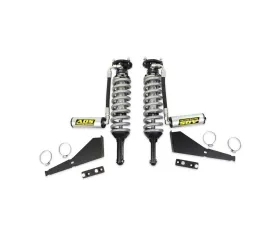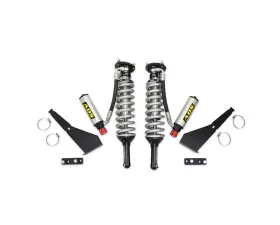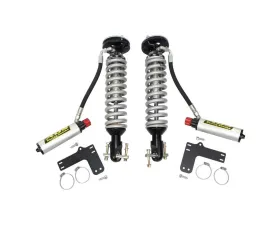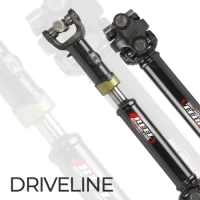Save with our Tax Refund Sale - Shop Now
Coilovers

1145 KONI Sport/Eibach Kit- 4 Sport (yellow) dampers, 4 Eibach lowering springs Saab 9-3 Sport Sedan 1999-2002

1996-2002 Toyota 4Runner 6-Lug - 2.5 in. Shock - Remote Reservoir - Compression Adjuster ADS Direct Fit Race Shock - Front

1996-2002 Toyota 4Runner 6-Lug - 2.5 in. Shock - Remote Reservoir ADS Direct Fit Race Shock - Front

1996-2002 Toyota 4Runner 6-Lug - 2.5 in. Shock - Remote Reservoir ADS Direct Fit Race Shock - Front

1996-2002 Toyota 4Runner 6-Lug - 2.5 in. Shock - Remote Reservoir ADS Direct Fit Race Shock - Front

1996-2004 Toyota Tacoma 4WD - 2.5 in. Shock - Remote Reservoir - Compression Adjuster - MCM Fab ADS Direct Fit Long Travel Race Shock - Front

1996-2004 Toyota Tacoma 4WD - 2.5 in. Shock - Remote Reservoir - MCM Fab ADS Direct Fit Long Travel Race Shock - Front

1996-2004 Toyota Tacoma 6-Lug - 2.5 in. Shock - Remote Reservoir - 600 lb. Spring Rate ADS Direct Fit Race Shock - Front

1996-2004 Toyota Tacoma 6-Lug - 2.5 in. Shock - Remote Reservoir - 650 lb. Spring Rate ADS Direct Fit Race Shock - Front

1996-2004 Toyota Tacoma 6-Lug - 2.5 in. Shock - Remote Reservoir - 700 lb. Spring Rate ADS Direct Fit Race Shock - Front

1996-2004 Toyota Tacoma 6-Lug - 2.5 in. Shock - Remote Reservoir - Compression Adjuster - 600 lb. Spring Rate ADS Direct Fit Race Shock - Front

1996-2004 Toyota Tacoma 6-Lug - 2.5 in. Shock - Remote Reservoir - Compression Adjuster - 650 lb. Spring Rate ADS Direct Fit Race Shock - Front

1996-2004 Toyota Tacoma 6-Lug - 2.5 in. Shock - Remote Reservoir - Compression Adjuster - 700 lb. Spring Rate ADS Direct Fit Race Shock - Front

2007-2018 Chevrolet Silverado 1500 4WD - 2.5 in. Shock - 0-3 in. Lift - Piggyback Reservoir ADS Direct Fit Race Shock - Rear

2007-2018 Chevrolet Silverado 1500 4WD - 2.5 in. Shock - 0-3 in. Lift - Remote Reservoir - 600 Spring Rate ADS Direct Fit Race Shock - Front

2007-2018 Chevrolet Silverado 1500 4WD - 2.5 in. Shock - 0-3 in. Lift - Remote Reservoir - 700 Spring Rate ADS Direct Fit Race Shock - Front

2007-2018 GM Tahoe/Yukon 1500 4WD - 2.5 in. Shock - 0-3 in. Lift - Piggyback Reservoir ADS Direct Fit Race Shock - Rear

2019-2023 Chevrolet Silverado 1500 4WD - 2.5 in. Rear - 0-3 in. Lift - Piggyback Reservoir ADS Direct Fit Race Shock - Rear

2019-2023 Chevrolet Silverado 1500 4WD - 2.5 in. Shock - 0-3 in. Lift - Piggyback Reservoir - Compression Adjuster ADS Direct Fit Race Shock - Rear

2019-2023 Chevrolet Silverado 1500 4WD - 3.0 in. Shock - Remote Reservoir - Compression Adjuster ADS Direct Fit Race Shock - Front

2019-2023 Chevy Silverado/GMC Sierra 1500 4WD - 2.5 in. Shocks w/ Remote Clicker Reservoir ADS Direct Fit Race Shocks - Front

2021-2023 Ford Bronco 4WD 2 Door - 2.5 in. Shock - 3-4 in. Lift - Remote Reservoir ADS Direct Fit Race Shock - Front

Performance Coilovers and Adjustable Coilovers
If you're interested in lowering your vehicle or improving its handling, one of the best ways to do so is with aftermarket coilovers. In fact, coilovers are one of the most popular modifications on the market for virtually any vehicle. Of course, not all vehicles can accept aftermarket coilovers, however, the large majority of modern vehicles can or do utilize them. The word “coilover” is derived from the term “coil over spring”, and is a type of suspension that allows you to adjust different aspects of your car’s ride height, damping, and camber.
Aftermarket coilovers are generally used to lower your car’s center of gravity for reduced weight transfer when changing direction, braking, or accelerating. With reduced weight transfer comes a more balanced load on each tire and more predictable handling. Apart from the handling and performance benefits, lowering your car on a set of coilovers will also improve its appearance by getting rid of the massive gap between the tire and the fender.
Most aftermarket coilovers work in conjunction with your suspension, allowing you to change the ride height, spring stiffness, damping stiffness, and more. It should be noted that not all coilovers are created equal; some are very basic and do the bare minimum, while others have innovative features that can drastically improve the way your car handles, accelerates, and looks. Whether you are more geared toward performance or just to show off your new stance at your next car show, a coilover kit will enhance your overall driving experience. Check out our selection of high-quality coilovers above.
Understanding Coilover Suspension Basics
Your typical suspension system includes a control arm (or two), coil spring, and a shock absorber or strut. When your car goes over a bump, the coil spring absorbs the energy of that bump and then pushes it back equally. If the spring operates without a damper, it will bounce up and down until the energy from the bump dissipates, but with a damper that energy is controlled, slowed down, and quickly dissipated.
When the spring is in motion, the damper stops it from bouncing through the use of rebound force and compression force. As the spring bounces, the shock resists the motion in both directions of the oscillation. In other words, the coil spring and damper work together to give you a smooth and controlled ride. It's important for these two to be tuned to work effectively together, otherwise, they can work against each other and give you poor ride quality.
Most OEM suspension systems are designed to provide great ride quality but at the cost of peak performance and handling. To ensure a smooth ride, OEM struts typically use low spring rates and very gentle damping. Unfortunately, soft springs and gentle damping equal pretty poor performance if you’re trying to go fast, and that is where aftermarket coilovers come in. Upgraded coilovers allow you to maintain a high level of performance for your vehicle by using stiffer spring rates, stiffer damping, and lower ride height.
Aftermarket coilovers are fundamentally similar to the OEM struts you’ll find on many vehicles. With that being said, an aftermarket coilover is typically lighter, smaller, and offers more adjustability than its factory counterpart. In short, it delivers better overall performance for your vehicle than an OEM strut does.
What Is in a Coilover Kit?
Coilovers replace your entire factory strut and typically have height and damping adjustments. Some coilovers also offer spring preload adjustment separate from the ride height adjustment. A coilover kit is pretty compact compared to old-school spring and shock suspension systems, as it typically consists of a spring, damper, and top-hat. Below, we provide a brief description of each component:
Springs
The springs you'll find with every aftermarket coilover work very similar to the OEM springs on your car. They support the vehicle and allow the suspension to operate without letting the vehicle bottoming out on the road. Different styles of coilovers utilize different springs, but they all perform the same job: support the vehicle, control how road force affects the chassis, and allow the suspension to cycle without the vehicle bottoming out.
Damper and Body
The damper helps keep your ride quality smooth and controlled by damping the spring oscillation. The damper is typically also the body of the coilover, which can include a threaded base for independent ride height adjustment on some coilovers. The body is typically built out of steel or aluminum, but some extremely high-end coilovers will feature more exotic and lightweight material. There are two different types of dampers: twin-tube and monotube. They operate in a similar fashion but each system has its own pros and cons which will be explored in detail further down.
Top Hat
The top hat covers the struts that work to keep the spring contained. The top hat is also what allows the top of the coilover to be bolted to your strut tower. With some top-hats you'll also find camber adjustment, which can have a massive impact on handling and braking performance, however, this adjustment is typically reserved for high-performance track-oriented coilovers.
What Are the Different Types of Coilover Springs?
When browsing the market for coilovers, you have the option of choosing between linear or progressive springs. Some springs deliver a smoother and more controlled ride, whereas others transfer more vibration to the cabin so you can keep track of exactly what your car is doing.
Linear Springs
Most high-end and track-oriented racing coilovers will use linear springs, as the constant spring rate of linear springs creates very predictable handling when pushing your car to the limits. When the spring compresses, the spring rate remains constant throughout the entire compression. While a car on linear springs will be easier to control and navigate on road courses or tracks, they do have a rougher ride than progressive springs.
Progressive Springs
Progressive springs, on the other hand, are generally better for street use. With progressive springs, the suspension will start out very soft and begin to stiffen as the suspension compresses. This allows for lower spring rates and much better ride quality all around, while still providing the superb handling you expect from coilover suspension kits.
To put it simply, unless you’re installing coilovers on a dedicated track car, progressive springs are the better option.
What Are the Different Types of Damper?
One of the main components of any coilover system is the damper. Without any damping, your suspension can compress and decompress freely, resulting in a bouncy ride and very poor handling. Performance coilovers typically come with two different kinds of dampers: twin-tube or monotube. From the outside, these two types of dampers may appear to be completely identical but, underneath there are quite a few fundamental changes that alter dampening performance.
Twin-Tube Damper
The twin-tube design is found on most low-end coilovers, OEM shocks, and even mid-level coilovers that are designed for street use. Twin-tube damping uses an inner and outer chamber. The inner tube holds the piston shaft, valve, and oil, while the outer tube holds damper oil and nitrogen gas. This design allows for more suspension stroke without increasing the height of the body, thus providing better ride quality. On the street, you really want as much travel as possible for your specific ride height, so this design is the go-to choice for most aftermarket coilover manufacturers.
Monotube Damper
You will notice that high-performance vehicles and race coilovers use a mono-tube design. This is because the monotube design holds everything in one tube and separates components by way of a floating piston. While this design is simpler than the twin-tube design, it allows for bigger and stronger parts, better heat dissipation, and quicker response. Heat is rarely an issue with street driving since speeds are much lower and the dampers aren't working extremely hard to keep everything under control.
Since the goal is to have shocks that quickly adjust to the environment around you without losing their efficiency, monotube dampers come out on top. Your suspension should feel stiffer in rough terrain or on the track and be much smoother when driving on the streets or freeway. Twin-tube shocks have a number of valves on the pistons that work independently. Monotube shock absorbers, on the other hand, spotlight a single valve assembly that evenly distributes pressure over the entire shock region.
Coilover Adjustments
When compared to an OEM suspension system, one of the biggest benefits of an aftermarket coilover is adjustability. With height adjustment, spring rate adjustment, and damping adjustment, you have the ability to fine-tune your car for your style of driving and any vehicle modifications. Some coilover kits offer minimal adjustments, while others offer plenty so you can really test the heights of your vehicle, no pun intended.
Spring Rate Adjustment
With the majority of aftermarket coilovers, the manufacturers determine the ideal spring rate either through testing or merely estimating. Even so, that spring rate is usually not completely fixed; there is some spring rate modification possible. This adjustment comes in the form of an adjustable collar that threads up and down the body and either compresses or decompresses the spring.
Adjusting the collar on the bottom of the springs affects the spring's pre-load which increases the amount of force necessary to compress the coilovers; at the same time, it does not increase the actual spring rate. With any of the adjustments mentioned below, it may be best to leave them up to a professional. This is because incorrect or improper adjustments can result in very poor handling and drivability.
On some coilovers, the collar that adjusts the spring rate also adjusts the ride height, however, many modern aftermarket coilovers have the ride height and spring pre-load adjustment seperate for improved adjustability
Ride Height Adjustment
While it is rare, some coilovers are not height or spring adjustable. Though you will typically either find a partially threaded coilover or a fully threaded coilover. The former allows height adjustment at the cost of suspension travel, while the latter allows spring pre-load and ride height to be adjusted independently. Having the ability to alter your car's ride height and spring pre-load independently results in far greater suspension tuning and enhances your overall driving experience.
With coilovers that offer separate ride height and spring pre-load adjustment, you'll find the lower mount is threaded onto the body. To lower the ride height, you unlock the collar on the lower mount and thread it up the body of the coilover, which effectively makes the coilover shorter.
Damper Adjustment
Many aftermarket coilovers also feature dampening adjustments. Some may only offer a few clicks of adjustability, while others can grant up to 32 clicks of adjustment. Some dampers also allow for the compression and rebound to be adjusted independently of one another. What's more, you will find that some aftermarket coilovers kits offer low-speed and high-speed dampening adjustments.
It's important to be careful with damper adjustments, as the wrong adjustments can have a major negative impact on handling and performance. For street use, it's typically best to leave your coilover set how it came in the box. On more basic coilovers, there is no damping adjustment and you're stuck with the factory settings, which can actually be a good thing in some cases since the factory setting is perfectly set for the given spring rate
Camber Adjustment
With some coilovers you'll also find camber adjustment. This works by effectively shifting the coilover inwards toward the vehicle or outwards away from the vehicle. This is done without moving the location of the top hat. This adjustment is only available on a few suspension designs. For example, a double-wishbone suspension design, cannot utilize this feature and would instead need a camber adjustable upper control arm to achieve the same adjustability.
Purchase Premium Coilovers and More From Vivid Racing
Apart from coilovers, Vivid Racing also offers a variety of performance suspension components, including leaf springs, lowering springs, air suspension kits, shocks & struts, and more. If you are interested in customizing your ride, we have got you covered! To learn more, contact us today by calling (480) 966-3040.

.jpeg?q=90&p=thumb&w=200&h=200)











.jpeg?q=90&p=thumb&w=40&h=40) Brakes
Brakes  Driveline
Driveline  Electronics
Electronics  Handlebars & Controls
Handlebars & Controls  Package Deals
Package Deals  Wheel Accessories
Wheel Accessories  Wheels by Vehicle
Wheels by Vehicle  Tools and Maintenance
Tools and Maintenance  Universal & Repair
Universal & Repair  Vivid Racing Gear
Vivid Racing Gear 
